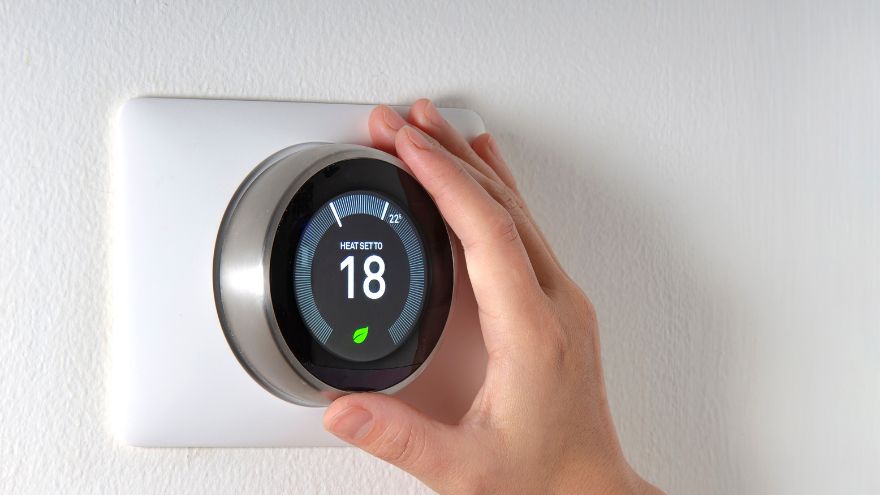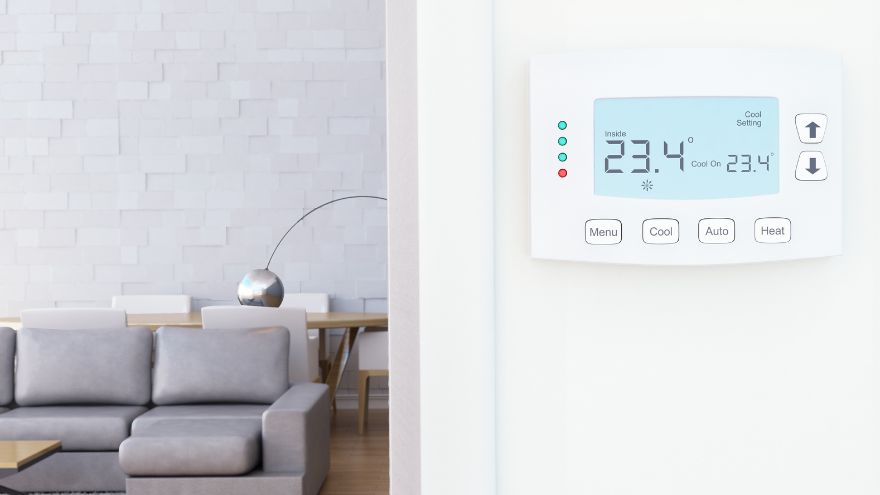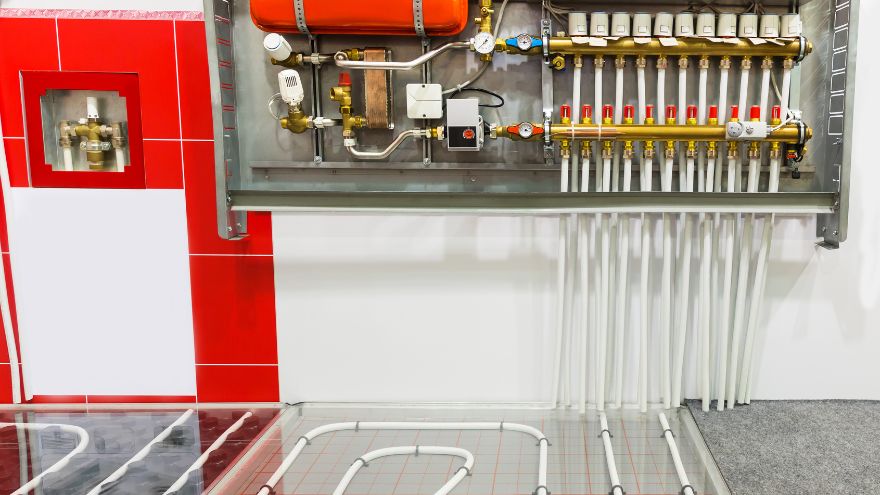There is no execution without management - this statement applies to many areas of life, and even to the so-called inanimate nature. Therefore, we invite you to read the guide on control systems for the increasingly popular (not only in single-family houses) underfloor heating.

Floor heating
Surface heating , popularly called underfloor heating or simply "underfloor heating", is a heating system in which the radiator in the room is not a device suspended at points on the wall, but the floor (usually on the entire surface). This happens thanks to pipes with the heating medium placed under the floor. This solution has a number of advantages: it heats the room very evenly (thanks to the large surface area), from the bottom up (the phenomenon of heat accumulation under the ceiling is minimized while the floor is cold) and provides the impression of high thermal comfort thanks to the transfer of heat when walking. Research has shown that cold is most felt in the feet, hands and face , so when we manage to warm these parts of the body, we naturally feel warm. In this respect, heating a room or bathroom through the floor makes perfect sense. In addition, there are aesthetic issues (installation elements are not visible) and practical issues (the air has higher humidity than with convection heating, and there is less dust in the air).
Controlling underfloor heating - centrally or within one room?
 However, for the floor to emanate pleasant warmth, piping installed under it is not enough, no matter how good the installer's work was. Automation is necessary to manage the operation of the entire system, as in the case of conventional radiators, regulated using a simple thermostat in the form of a knob. A thermostat for "underfloor heating" can also operate on the principle of a knob, but between it and the heating elements there is a thermal actuator that regulates the heating or cooling of the water in the circulation and adjusts its temperature to the needs of the household members. However, it must be remembered that surface heating, despite the advantages already mentioned, is characterized by relatively high thermal inertia , which means a delay between issuing a command by the room thermostat and its execution by the pipes under the panels or terracotta.
However, for the floor to emanate pleasant warmth, piping installed under it is not enough, no matter how good the installer's work was. Automation is necessary to manage the operation of the entire system, as in the case of conventional radiators, regulated using a simple thermostat in the form of a knob. A thermostat for "underfloor heating" can also operate on the principle of a knob, but between it and the heating elements there is a thermal actuator that regulates the heating or cooling of the water in the circulation and adjusts its temperature to the needs of the household members. However, it must be remembered that surface heating, despite the advantages already mentioned, is characterized by relatively high thermal inertia , which means a delay between issuing a command by the room thermostat and its execution by the pipes under the panels or terracotta.
A higher form of initiation is temperature regulation divided into individual rooms. In such a case, separate room thermostats are installed, connected to a master controller, each output of which is used to control a thermal actuator responsible for one room, e.g. a living room or bathroom. This solution is more technically complex and therefore more expensive to implement, but it brings savings in the long run because it allows you to avoid heating unused rooms . It also prevents "thermal hegemony", i.e. the temperature set on the central thermostat being imposed on all rooms by the household member who has access to it at a given time. You have to weigh all the pros and cons.
Check out the offer of thermostats at the Onninen wholesaler
Which temperature sensor should I choose?
Sensors are indispensable elements of the temperature control system. They are the "noses" of the entire system, thanks to which the control automation knows whether the water in the system needs to be heated or cooled to achieve the temperature set by the user . The sensors can be connected to the control strip wired or wirelessly, but we feel that showing the advantage of one over the other would be like proving the superiority of Christmas over Easter, so we do not take a diplomatic position. As a statement of fact, we will only say that wireless devices require battery power. However, it is important that there is a pair of sensors - they serve as reference points for each other, and none of them can do anything alone. Here's entropy in a real-life example.
Floor temperature sensors
 The sensor located in the floor, in cooperation with the air sensor and the wall regulator, decides to increase or decrease the temperature of the heating water in the system. Figuratively speaking, it tells the smoker to "throw it into the stove" or, on the contrary, gives the smoker a moment of respite. It also prevents overheating of system elements and ensures that the temperature in the peripheral zones remains higher than in the center of the room . It also maintains the floor surface temperature at the level set by the user, if the system has such a function. This is particularly important, for example, in the bathroom, where people walk barefoot more often than in other rooms.
The sensor located in the floor, in cooperation with the air sensor and the wall regulator, decides to increase or decrease the temperature of the heating water in the system. Figuratively speaking, it tells the smoker to "throw it into the stove" or, on the contrary, gives the smoker a moment of respite. It also prevents overheating of system elements and ensures that the temperature in the peripheral zones remains higher than in the center of the room . It also maintains the floor surface temperature at the level set by the user, if the system has such a function. This is particularly important, for example, in the bathroom, where people walk barefoot more often than in other rooms.
Air temperature sensors
While the floor temperature sensor is the contractor, the air temperature sensor is the manager - it determines whether the air in the room is already heated to the level desired by the user and issues the appropriate command to its "down-to-earth" colleague. The air temperature sensor is also important because it is based on its readings that the result is displayed on the thermostat display or on a room thermometer, suggesting the user to increase or decrease the temperature (the indication sometimes means more than the subjective feeling of heat).
Types of regulators and product overview
- Electronic daily room temperature controller - electronic room temperature controller 230 V - daily; PWM system; VP valve protection function; NSB temperature reduction function; easy to install; dedicated to underfloor heating systems, connection to the KL06 control strip;
- Central strip for underfloor heating - simple installation using PLUG-IN technology; possibility of connecting max. six thermostats and up to 24 actuators; clear and unambiguous labeling of terminals; integrated LED system informing about the operating status; surface marking for easy identification;
- Thermoelectric actuator - the thermoelectric actuator is designed to control the heating installation; can be used with valve inserts in the manifold for underfloor heating or with zone valves; allows you to open or close the flow of heating medium in the loop, ensuring temperature control; cooperates directly with the regulator or indirectly via the control strip; 5 years warranty; “First Open” function – facilitates the first installation; low power consumption; fast opening time; small dimensions; modern design, high durability;
- Electronic actuator for underfloor heating - thermostatic control valve - head/actuator 230 V, normally closed, works with a 230 V automation strip, controlled by a 230 V room thermostat; weight: 0.15 kg; intelligent control of underfloor heating in every room; time program for 3 zones (central, A and B); one master thermostat for one automation strip with an expansion module, up to 12 slave thermostats, up to 24 actuators for each strip; ability to control heating or cooling; heating and cooling module - possibility of cooperation with a heat pump and recuperator; communication within a radius of 50 m in a typical building;
- Actuator normally closed - NC electric actuator, normally closed.